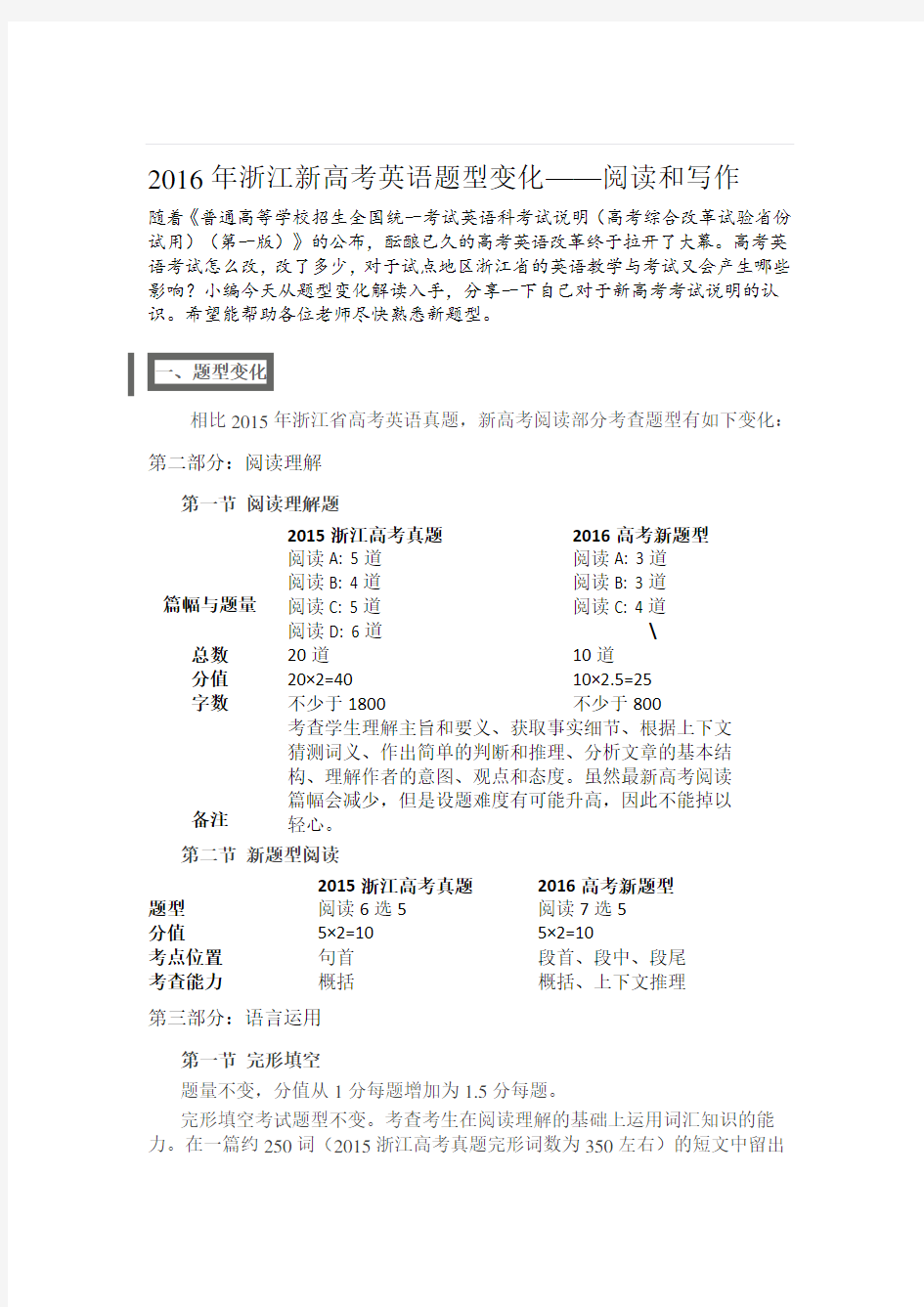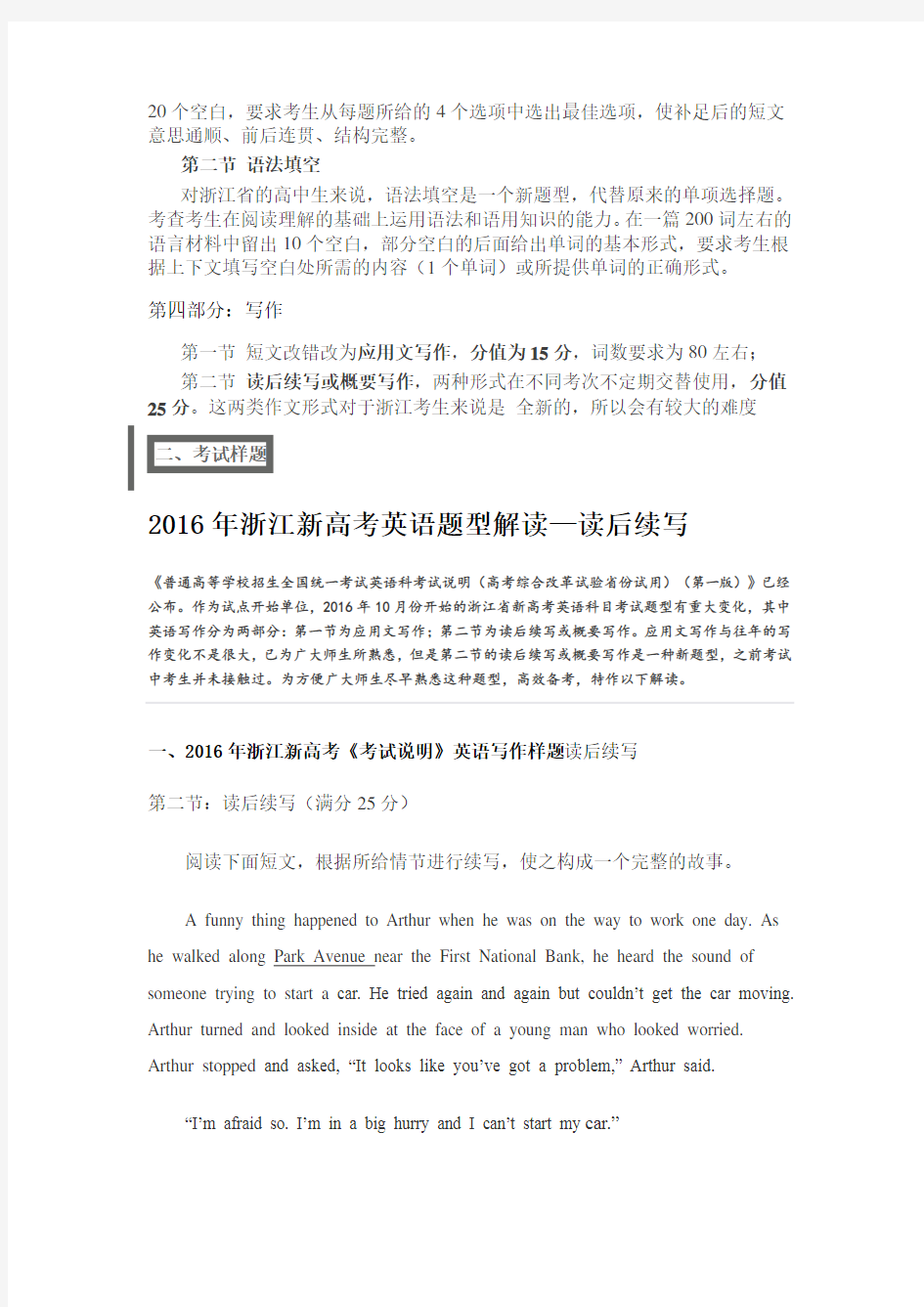新高考英语题型变化


2016年浙江新高考英语题型变化——阅读和写作
随着《普通高等学校招生全国统一考试英语科考试说明(高考综合改革试验省份试用)(第一版)》的公布,酝酿已久的高考英语改革终于拉开了大幕。高考英语考试怎么改,改了多少,对于试点地区浙江省的英语教学与考试又会产生哪些影响?小编今天从题型变化解读入手,分享一下自己对于新高考考试说明的认识。希望能帮助各位老师尽快熟悉新题型。
一、题型变化
相比2015年浙江省高考英语真题,新高考阅读部分考查题型有如下变化:第二部分:阅读理解
第一节阅读理解题
2015浙江高考真题2016高考新题型
篇幅与题量阅读A: 5道阅读A: 3道阅读B: 4道阅读B: 3道阅读C: 5道阅读C: 4道阅读D: 6道\
总数20道10道
分值20×2=40 10×2.5=25 字数不少于1800 不少于800
备注考查学生理解主旨和要义、获取事实细节、根据上下文猜测词义、作出简单的判断和推理、分析文章的基本结构、理解作者的意图、观点和态度。虽然最新高考阅读篇幅会减少,但是设题难度有可能升高,因此不能掉以轻心。
第二节新题型阅读
2015浙江高考真题2016高考新题型
题型阅读6选5 阅读7选5
分值5×2=10 5×2=10
考点位置句首段首、段中、段尾
考查能力概括概括、上下文推理
第三部分:语言运用
第一节完形填空
题量不变,分值从1分每题增加为1.5分每题。
完形填空考试题型不变。考查考生在阅读理解的基础上运用词汇知识的能力。在一篇约250词(2015浙江高考真题完形词数为350左右)的短文中留出
20个空白,要求考生从每题所给的4个选项中选出最佳选项,使补足后的短文意思通顺、前后连贯、结构完整。
第二节语法填空
对浙江省的高中生来说,语法填空是一个新题型,代替原来的单项选择题。考查考生在阅读理解的基础上运用语法和语用知识的能力。在一篇200词左右的语言材料中留出10个空白,部分空白的后面给出单词的基本形式,要求考生根据上下文填写空白处所需的内容(1个单词)或所提供单词的正确形式。
第四部分:写作
第一节短文改错改为应用文写作,分值为15分,词数要求为80左右;
第二节读后续写或概要写作,两种形式在不同考次不定期交替使用,分值25分。这两类作文形式对于浙江考生来说是全新的,所以会有较大的难度
二、考试样题
2016年浙江新高考英语题型解读—读后续写
《普通高等学校招生全国统一考试英语科考试说明(高考综合改革试验省份试用)(第一版)》已经公布。作为试点开始单位,2016年10月份开始的浙江省新高考英语科目考试题型有重大变化,其中英语写作分为两部分:第一节为应用文写作;第二节为读后续写或概要写作。应用文写作与往年的写作变化不是很大,已为广大师生所熟悉,但是第二节的读后续写或概要写作是一种新题型,之前考试中考生并未接触过。为方便广大师生尽早熟悉这种题型,高效备考,特作以下解读。
一、2016年浙江新高考《考试说明》英语写作样题读后续写
第二节:读后续写(满分25分)
阅读下面短文,根据所给情节进行续写,使之构成一个完整的故事。
A funny thing happened to Arthur when he was on the way to work one day. As he walked along Park Avenue near the First National Bank, he heard the sound of someone trying to start a car. He tried again and again but couldn’t get the car moving. Arthur turned and looked inside at the face of a young man who looked worried. Arthur stopped and asked, “It looks like you’ve got a problem,” Arthur said.
“I’m afraid so. I’m in a big hurry and I can’t start my car.”
“Is there something I can do to help?” Arthur asked. The young man looked at the two suitcases in the back seat and then said, “Thanks. If you’re sure it wouldn’t be too much trouble, you could help me get these suitcases into a taxi.”
“No trouble at all. I’d be glad to help.”
The young man got out and took one of the suitcases from the back seat. After placing it on the ground, he turned to get the other one. Just as Arthur picked up the first suitcase and started walking, he heard the long loud noise of an alarm.
It was from the bank. There had been a robbery (抢劫)!
Park Avenue had been quiet a moment before. Now the air was filled with the sound of the alarm and the shouts of people running from all directions. Cars stopped and the passengers joined the crowd in front of the bank. People asked each other, “What happened?” But everyone had a di fferent answer.
Arthur, still carrying the suitcase, turned to look at the bank and walked right into the young woman in front of him.
She looked at the suitcase and then at him. Arthur was surprised. “Why is she looking at me like that?” He thought. “The suitcase! She thinks I’m the bank thief!”
Arthur looked around at the crowd of people. He became frightened, and without another thought, he started to run.
注意:
1. 所续写短文的词数应为150左右;
2. 应使用5个以上短文中标有下划线的关键词语;
3. 续写部分分为两段,每段的开头语已为你写好;
4. 续写完成后,请用下划线标出你所使用的关键词语。
Paragraph 1:
As he was running, Arthur heard the young man shouting behind, “Stop,stop!”
_________________________________________________________________
Paragraph 2:
The taxi stopped in front of the Police Station and Arthur...
_________________________________________________________________范文(原创范文,仅供参考)
One possible version:
As he was running, Arthur heard the young man shouting behind,
“Stop, stop!” And also at the moment, Arthur suddenly realized
that the young man might be the bank robber. So A rthur didn’t stop,
but continued to run until he saw a taxi. He stopped it, jumped in with
the suitcase and said to the driver, “Go to the police station,
please. The man shouting behind is the bank thief!’’ The taxi raced
away like the wind.
The taxi stopped in front of the Police Station and Arthur told the
police what had happened. Obviously, the police had already learned
about the robbery. They opened the suitcase and there was a large sum
of money inside, as Arthur had expected. Then the police asked Arthur
to describe the young man and the other suitcase. Later, with the
information, the police caught the robber. The police and the bank both
thanked Arthur a lot. (Words 153)
Another possible version:
As he was running, Arthur heard the young man shouting behind,
“Stop, stop!”Thinking of the way the young man had behaved, he
realized the young man might be the bank robber. So Arthur ran faster
and stopped a taxi. The moment he got into the taxi, he told the driver the man shouting behind was the bank thief and asked him to drive to the nearest police station. The driver followed what Arthur said and drove away.
The taxi stopped in front of the Police Station and Arthur thanked the driver and directly went in. Just as Arthur was describing what had happened near the bank on the Park Avenue and reported the young man to the police, he heard a voice outside, “Help! Help!” To the surprise of Arthur, it was the young man. He had followed Arthur in another taxi. It turned out that the young man was innocent and inside the suitcases were just some clothes. Arthur felt embarrassed but the policemen thanked him anyway.(Words: 158)
【范文点拨】
原文所给关键词分类:
地点:Park Avenue, the bank
人物:The young man, people, the bank thief
事件:suitcases, in the back seat, loud noise of an alarm, robbery, the shouts
在续写时,除了注意原文给出的关键词,还需要注意以下线索:
1. Why did the young man look worried?
2. What happened? But everyone had a different answer.
3. Arthur became frightened and without another thought, he started to run.
二、题型解读读后续写
1. 题型介绍
◆选材特点
(1)所需阅读的短文词数在350以内;
(2)多以记叙文故事类文章或者夹叙夹议类文章为主,故事情节有曲折、有起伏,但是,故事线索的逻辑性比较强。
◆评分参考
阅卷时主要考虑以下内容:
(1)与所给短文及段落开头语的衔接程度;
(2)内容的丰富性和对所给关键词语的覆盖情况;
(3)应用语法结构和词汇的丰富性和准确性;
(4)上下文的连贯性。
注意:
(1)所续写短文的词数应为150左右(词数少于130的,从总分中减去2分);
(2)应使用5个以上短文中标有下划线的关键词语;
(3)续写部分分为两段,每段的开头语已为你写好;
(4)续写完成后,请用下划线标出你所使用的关键词语。
2. 考查能力
读后续写是一种将阅读与写作紧密结合的考查形式,旨在考查学生的综合语言运用能力。与应用文不同,故事续写除了要求学生掌握丰富的词汇和句式外,还注重学生的内容构思和情节衔接的能力。主要聚焦在以下四个方面:
一是把握短文关键信息和语言特点的能力。学生需要了解给定短文的主要内容,清楚其关键词和语言结构的使用情况,并通过续写短文表现出来。
二是语言运用的准确性和丰富性。期望学生在词汇和语言结构的使用方面准确、恰当,能够根据内容需要使用较为高级的词汇和语言结构,阅卷老师会感觉这个学生很有水平。
三是对语篇结构的把控能力。考查学生对上下文逻辑关系的掌握情况,希望学生续写的短文语句连贯、有序。
四是创造性思维能力。这是对学生续写短文内容得要求,期望学生续写的短文具有较丰富的内容。该试题具有一定的开放性,要求学生详细和生动地描述情景、态度和感情,符合课程标准的要求和学生的能力水平(刘庆思,陈康,2016)。
3.续写特点
读后续写,简言之,就是阅读完一篇还未写完的文章之后,根据要求和提示把这篇文章未写完部分补充完整,使之浑然一体。它一方面很好地考查考生对所学语言知识的实际运用能力,而另一方面,它也培养学生的发散思维能力。根据《考试说明》该部分的规定,考生在续写文章时,要注意续写部分“与所给短文及段落开头语的衔接程度”,“内容的丰富性和对所标出关键词语的应用情况”,“应用语法结构和词汇的丰富性和准确性”以及“上下文的连贯性”。根据这些规定,我们会发现读后续写有如下特点:
(1)读后续写不是随心所欲,是要在引导语(开头语)和提示词的帮助下完成续写部分。如《考试说明》样题中规定“应使用5个以上短文中标有下划线的关键词语(10处)”。这些关键词语类似于传统写作中的要点提示,如人物、地点、事件,但是不同点在于这些关键词语并不是全用。这样考生可根据自己的理解有很大的自主权。另外,所续写部分不能脱离各自段落的首句开头语,即:不能另起炉灶。这些开头语与传统写作中的开头语类似,在某种程度上引导你的思路向哪方面发展。
(2)续写短文多以记叙文故事类文章或者夹叙夹议类文章为主,故事情节有曲折、有起伏,但是,故事线索的逻辑性比较强。这样考生能够根据提示词语,顺着原来文章的思路续写文章,并适当发散。
(3)读后续写要求读写并重。与阅读理解题一样,读后续写同样需要对本篇文章精确理解,这样所续写部分才不至于偏离主题,就这方面而言有点类似阅读理解题中对文章后续发展的推断,如“What would happen next?”。
